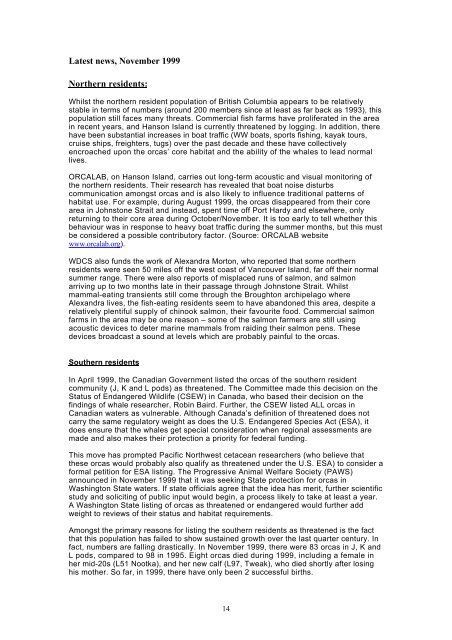Captive Orcas 'Dying to Entertain You' - Whale and Dolphin ...
Captive Orcas 'Dying to Entertain You' - Whale and Dolphin ...
Captive Orcas 'Dying to Entertain You' - Whale and Dolphin ...
You also want an ePaper? Increase the reach of your titles
YUMPU automatically turns print PDFs into web optimized ePapers that Google loves.
Latest news, November 1999Northern residents:Whilst the northern resident population of British Columbia appears <strong>to</strong> be relativelystable in terms of numbers (around 200 members since at least as far back as 1993), thispopulation still faces many threats. Commercial fish farms have proliferated in the areain recent years, <strong>and</strong> Hanson Isl<strong>and</strong> is currently threatened by logging. In addition, therehave been substantial increases in boat traffic (WW boats, sports fishing, kayak <strong>to</strong>urs,cruise ships, freighters, tugs) over the past decade <strong>and</strong> these have collectivelyencroached upon the orcas’ core habitat <strong>and</strong> the ability of the whales <strong>to</strong> lead normallives.ORCALAB, on Hanson Isl<strong>and</strong>, carries out long-term acoustic <strong>and</strong> visual moni<strong>to</strong>ring ofthe northern residents. Their research has revealed that boat noise disturbscommunication amongst orcas <strong>and</strong> is also likely <strong>to</strong> influence traditional patterns ofhabitat use. For example, during August 1999, the orcas disappeared from their corearea in Johns<strong>to</strong>ne Strait <strong>and</strong> instead, spent time off Port Hardy <strong>and</strong> elsewhere, onlyreturning <strong>to</strong> their core area during Oc<strong>to</strong>ber/November. It is <strong>to</strong>o early <strong>to</strong> tell whether thisbehaviour was in response <strong>to</strong> heavy boat traffic during the summer months, but this mustbe considered a possible contribu<strong>to</strong>ry fac<strong>to</strong>r. (Source: ORCALAB websitewww.orcalab.org ).WDCS also funds the work of Alex<strong>and</strong>ra Mor<strong>to</strong>n, who reported that some northernresidents were seen 50 miles off the west coast of Vancouver Isl<strong>and</strong>, far off their normalsummer range. There were also reports of misplaced runs of salmon, <strong>and</strong> salmonarriving up <strong>to</strong> two months late in their passage through Johns<strong>to</strong>ne Strait. Whilstmammal-eating transients still come through the Brough<strong>to</strong>n archipelago whereAlex<strong>and</strong>ra lives, the fish-eating residents seem <strong>to</strong> have ab<strong>and</strong>oned this area, despite arelatively plentiful supply of chinook salmon, their favourite food. Commercial salmonfarms in the area may be one reason – some of the salmon farmers are still usingacoustic devices <strong>to</strong> deter marine mammals from raiding their salmon pens. Thesedevices broadcast a sound at levels which are probably painful <strong>to</strong> the orcas.Southern residentsIn April 1999, the Canadian Government listed the orcas of the southern residentcommunity (J, K <strong>and</strong> L pods) as threatened. The Committee made this decision on theStatus of Endangered Wildlife (CSEW) in Canada, who based their decision on thefindings of whale researcher, Robin Baird. Further, the CSEW listed ALL orcas inCanadian waters as vulnerable. Although Canada’s definition of threatened does notcarry the same regula<strong>to</strong>ry weight as does the U.S. Endangered Species Act (ESA), itdoes ensure that the whales get special consideration when regional assessments aremade <strong>and</strong> also makes their protection a priority for federal funding.This move has prompted Pacific Northwest cetacean researchers (who believe thatthese orcas would probably also qualify as threatened under the U.S. ESA) <strong>to</strong> consider aformal petition for ESA listing. The Progressive Animal Welfare Society (PAWS)announced in November 1999 that it was seeking State protection for orcas inWashing<strong>to</strong>n State waters. If state officials agree that the idea has merit, further scientificstudy <strong>and</strong> soliciting of public input would begin, a process likely <strong>to</strong> take at least a year.A Washing<strong>to</strong>n State listing of orcas as threatened or endangered would further addweight <strong>to</strong> reviews of their status <strong>and</strong> habitat requirements.Amongst the primary reasons for listing the southern residents as threatened is the factthat this population has failed <strong>to</strong> show sustained growth over the last quarter century. Infact, numbers are falling drastically. In November 1999, there were 83 orcas in J, K <strong>and</strong>L pods, compared <strong>to</strong> 98 in 1995. Eight orcas died during 1999, including a female inher mid-20s (L51 Nootka), <strong>and</strong> her new calf (L97, Tweak), who died shortly after losinghis mother. So far, in 1999, there have only been 2 successful births.14
















